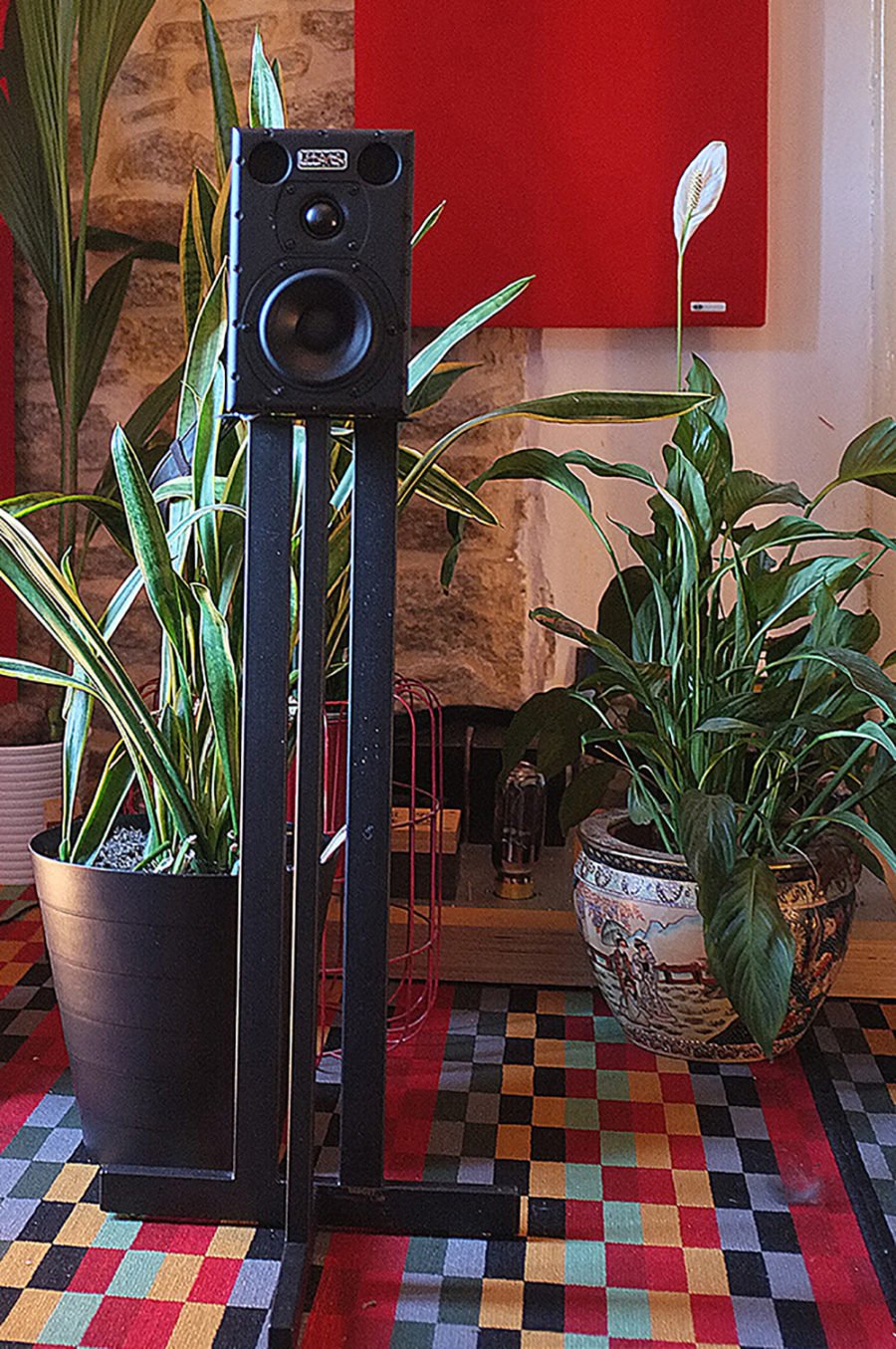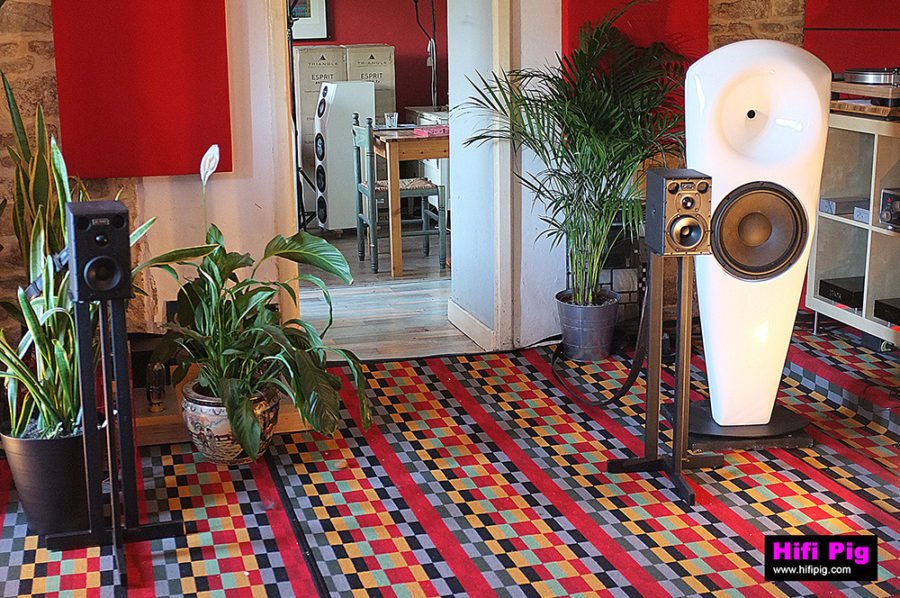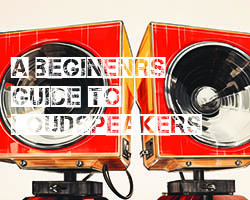The original Leema Xen was initially designed as a “cost no object” nearfield monitor for use in studios and the like, but then it was embraced somewhat by those in audiophile circles. Stuart Smith takes a listen to this diminutive £1295 loudspeaker that hails from Wales.
Each speaker is a tiny little thing measuring just 21cm x 14cm x 20cm (HWD) and has a volume of just five litres. There’s a 10cm woofer and a soft dome tweeter coupled with a pair of front firing ports and the whole package looks tremendously well put together, feeling solid and weighty enough. The knock test suggests the cabs are far from absolutely dead and this is to be expected as they are thin walled, but they don’t sound overly hollow, ringy or empty. The cabinet is made from 1.2mm steel sheet then lined with a bitumastic material and then lambs wool. 
Down each side of the speaker is a large bolt in the cabinet which I assume is to add a degree of rigidity. Round the back you’ve got two pairs of speaker binding posts on a plate that covers the whole of the back of the speaker and this is bolted onto the main chassis. On this plate is also a frequency response graph showing that the little Xens roll off at 57 Hz (-3dB – (the website says -6dB)) and go all the way up to 25kHz. They are quoted as being 85dB efficient and have an impedence of 6 Ohms. The website says that the efficiency is “good” but you will need to have a power amp capable of delivering a decent amount of welly to the Xens to get them singing as they should…flea power valve amps need not apply.
SOUND
They look pretty cool I reckon in a stealth-black kind of way and I had them perched on 70cm stands which brought the tweeter perfectly to ear height in my listening position…there are no grills supplied or available but I rarely use speakers with grills on anyway. I had the speakers in our large listening room and I genuinely thought they would be lost in this space, but I was very pleasantly surprised indeed. I had them 150cm apart, with me sat 170cm away bang in the middle, with them being well away from both rear and side walls…so sort of nearfieldish to midfieldish positioning.
Power was supplied by a pair of Merrill Thor Monoblocks fed with a signal direct from the Lampizator Big7 DAC. Speaker cables were from Tellurium Q Ultra Blacks on this occasion, with interconnects and power cables being a mix of Atlas, Vermouth and Chord Company.
As mentioned in the preamble, the Xens were originally designed for nearfield monitoring and I’m very familiar with this kind of speaker, having sat in front of them for years and years in studios. First impressions are that the Xens are typical of the very best of this kind of monitor, with them feeling accurate, balanced and composed. Of course they don’t go super low, but you know what, you don’t always miss trouser flapping bass when the mids are just so “right”. I can see some people reading this and saying “Surely this isn’t Stuart reviewing these, we all know he likes his bass strong and taut” but guess what, with the right kind of program you can get a good deal of enjoyment from these despite he lack of bass. Popping a bit of spoken word on the stereo is a good thing to do when testing speakers and I did this with the Xens where you get a pretty natural sounding voice, without a hint of nasality to it.
The Xens throw a huge stage and whilst they don’t disappear (I think that’s a bit of a hifi cliché anyway) the music does extend beyond the left and right of the speakers, with instruments remaining just where they should in the mix…again just what you would want from a loudspeaker designed for the studio. Imaging is great and you get a real feel for the mix…again just as you would expect! They throw a good image in three dimensions too.
One of the issues I often have with this kind of loudspeaker designed essentially (or initially) for pro use is that they can sound a bit boring and sterile, but the Xens just don’t. Yes they feel accurate and what not, but you can actually listen to music on them…and enjoy it a good deal into the bargain. They’re not warm and cuddly though, something I hate in a speaker and which to me suggestsg that there is an over exaggeration in the lower-mid/upper-bass frequencies…nope these sound flat and truthful to the source material. I once had a bit of a discussion in the days before I learned to keep away from the dreaded beast that is hifi fora about loudspeakers being flat. Basically the chap I was discussing this suggested that if in room response was flat then the speakers were good. I disagreed and moaned about the crossover adding something to the mix that was audible. Well the Xens are pretty much flat and I don’t reckon that the crossover is doing the majority of the work here…clever design, careful choice of drivers and a crossover that is sympathetic is how I would describe the Xens.
I said earlier that I fully expected the Xens to get totally lost in our listening room, and if you aren’t sympathetic to their size they sort of can get lost, but set them up as I did (near/midfield) and you will be rewarded handsomely!! The average person buying the Xens isn’t going to be placing them in a huge space anyway and in a normal sized sitting room they will be perfectly fine…and played loudly they are a right laugh and great fun. They certainly give you a great insight into the recording you are listening to (as you’d expect) but they aren’t so over analytical as to be ruthless to the recording you are trying to enjoy, or give you so much information overload that you feel like you are listening out for errors in the recording, rather than sitting back and enjoying the music…this is a fine balancing act to do but the Xens pull it off with aplomb.
The speakers integrate all the frequencies really nicely and are evenhanded, with nothing jumping out and coming to the fore frequency-wise. Again, this is to be expected given they are monitors, if anything there is a little lift at the very top end, but this only serves as to add a little air, space and what not to the tunes. Box speakers are always coloured to a greater or lesser extent and of course there is colouration here too (show me a speaker that isn’t) but it’s not huge and it’s more than livable with.
I had a bit of a shuffle in my seating position away from the “hotspot” and found that I could still enjoy a very satisfactory stereo image anywhere on the couch and this means that you can sit and listen with your friends too should you be of that bent. 
Of course I need to talk you through a few of the tunes I listened to on the Xens or this review would not be a complete review and so first up we have some jazz-funk/P funk in the guise of Mtume’s “Kiss the World Goodbye”. Here we have lovely crisp hats and that whole flying round your head feel to the top end, and vocals come across as being balanced and correct. Effects (phaser surprise, surprise) on Phase 1 (40 Seconds Dedicated To All Conga Players) sound like they should and when the next tune (Day Of The Reggin) comes in the Xens react quickly and spritely. I suppose this is one of the huge benefits of little, well designed loudspeakers like the Xens – they are fast, nimble and agile. On this kind of music I would have loved to have a bit more of that lovely tight bass (the Xens don’t do much below 60Hz) and this got me thinking as to what these would sound like with a really well integrated sub. Sadly I’ve not got a separate sub, BUT if you could have this pinpoint accuracy and speed of the Xens but with just that extra 20 or so Hertz further down the registers you’d be like the proverbial pig in muck and well pleased with yourself for being so clever and getting these speakers.
One of the highlights of the Xens for me was female vocals and on the same Mtume album and the track This Is Your World, the woman singer comes in and there’s just none of that ear-cringing-“that’s-bright” reaction that you can sometimes get with some loudspeakers just before the high note that you know is coming…a sort of “oh god this is gonna be horrible” feeling where you squint your eyes and pull your head in a bit…it just doesn’t happen with the Xens at all and they feel composed, unruffled and in control. This isn’t to suggest that the Xens are overly polite or trying to hide things, it’s just they don’t screech and shout at you, if that makes sense.
CONCLUSION
I really enjoyed these loudspeakers and I can heartily recommend that if you are in the market for a small pair of well made speakers then you should certainly have these on your short list. They cost £1295 which seems a lot for such a diminutive package, but the proof is in the pudding and all that and clearly there has been a lot of research and development that has gone into this cleverly designed loudspeaker. On top of that the Xens from Leema are very nicely made indeed and feel solid and sturdy. Appearance wise they look really cool and because of their size they should find favour in all but the pickiest of homeowners rooms.
Due to the forward firing port the Xens are easy to locate, with Leema suggesting they will be ok on bookshelves etc. I didn’t try this as it just wasn’t practical but I have no reason to doubt this given the ease with which I positioned them in our room. 
Standout feature to the sonics of the Xens is the lovely even-natured mid-band that integrates beautifully with the upper registers. On the downside bass will be lacking for some, but to be fair to the Xens, in a normally proportioned space, anything lower than 50Hz or so will need taming with room treatment…something just not practical for most people. So here we have a compromise, but it is a sensible compromise that is well thought out and intelligent…don’t have the frequencies there that are going to give you issues and you just won’t have issues! Personally I think the Xens would benefit from an optional and matching sub to fill in the bottom end a little – built by Leema it would, I’m sure be perfectly integrated and a popular add on.
Yes, the Xens are going to struggle to an extent I huge spaces, but even here, if you set them up properly and position your listening chair midfield you should have little to moan about.
As always the question is always “Could I live with them” and the response here is a definite yes…with a caveat – I prefer my big horns and subs of course in our main listening space, but if I was to add a second system, say in the bedroom or in our television/lounge area which is more of a normal size, then I’d snap these up in an instant. In fact I did snap them up and I’ll be using them as our reference for mid priced kit reviews.
Build Quality: 8.75/10
Value for money: 8.65/10
Overall: 8.75/10
Pros:
Beautifully balanced yet revealing
Easy to position
Solid build and decent finish
Fast and responsive
Cons:
Bass will be lacking for some
Stuart Smith
Designer’s Notes
Both Mallory and I were very early adopters of surround sound at home, way before Dolby stereo decoders for home use were widely available…..I was after all a TV and Cinema sound mixer in my proper job.
I purchased a very expensive VHS machine which featured Nicam…and more importantly……adjustable tracking……in the late eighties…it cost about £1000…sounds like a lot of money now, but in 1985 I bought my first flat…in Earls Court London…for £25,000 (probably worth about a million now….oh the joys of separation :-) So back then it was the price of a decent car.
The important thing is that I could access the HiFi track encoded in the picture and adjust the tracking to get rid of the horrible chopping sound that resulted from poor line up.
The HiFi track on pre-recorded VHS tapes was usually encoded in Dolby Stereo (a two channel phase encoded surround system).
Dolby stereo is loosely based on the Hafler principle so I wired my living room system with a stereo amplifier and four speakers connected in a Hafler network (see below from Everyday Electronics 1975.
This worked spectacularly well
No discrete centre, but with a decent set of speakers, the phantom centre image was more than adequate.
I used this system for quite a while, but then two things happened which forced me to change:-
- I got married.
- I suddenly noticed three little girls running around the house who all insisted on calling me daddy! …don’t remember ordering them but there you are.
Now I should explain that the front speakers were a pair of transmission line four way monitors that my Father and I built in the 70’s from an article in HiFi answers magazine…only my father made them bigger because he said “they” had got the maths wrong for the line! May seem a funny thing to say but my father turned down Mensa membership because they were “all too stupid”. He was probably right.
Consequently they sounded great but were less than domestically friendly…about 6 feet tall, 18 inches wide and 2 feet deep….solid mahogany…they are probably living on as someone’s dining table even now.
Following some fairly exhaustive discussions with the current Mrs T, we decided (Ahem….the Royal we) to downsize the speakers so she could actually get some furniture in.
So… what to use instead…despite what you may have heard, the mid to late nineties were not a great period for loudspeakers….if you wanted something neutral and monitor like.
Mallory and I decided the only thing to do was build our own…and just to make it “interesting” the new speaker would have a maximum volume of 5 litres, thin wall cabinet construction and would comply with BBC grade 2 monitor spec (plus or minus 2dB max with limited low frequency capability). Sounds quite straightforward but it proved to be anything but.
We really wanted the new speaker to work on its own, with sufficient bass output to make the use of a subwoofer optional.
The thing is that most loudspeaker drive units want lots of volume to make bass. The technical parameters for small box driver units are very specific and hard to achieve.
We originally designed the Xen (as it came to be known) as an isobaric using two Audax paper drivers…which they handily discontinued just as we were going to make the first set!
So the search was on for a replacement…we tried dozens, if not hundreds of drive units from many manufacturers and most simply did not perform correctly….in fact we ended up writing a suite of software tools ourselves to aid in the design because most of the information out there was too course, with significant rounding errors, in fact it made it very clear that much commercial loudspeaker design at that time was a combination of maths and “suck it and see”.
The only company that understood what we were trying to do were Seas in Norway, who came to the rescue with a terrific driver…perfect parameters, good linear cone excursion, excellent power handling and….very important in those pre-flat screen times…they could make it magnetically screened!
So the Xen was completely redesigned around the new driver.
The Seas drive unit had a resonant frequency of 57Hz which is very low for a four inch diameter unit. This made the ports difficult to squeeze in to the box because they are 10 inches long….bigger than the longest dimension of the cabinet. So they had to be made with a bend part way down.
Two ports were used to avoid port noise. It is important to keep the velocity of the column of air in the port below 0.1 mach (the speed of sound) otherwise it behaves as a solid and generates noise of its own…usually heard as chuffing or distortion.
Also, inadequate porting leads to compression because too much friction is produced so the air cannot move easily.
The cabinet is formed from 1.2mm steel sheet then lined with a bitumastic material from the automotive industry to damp resonance.
The cabinet is then lined with sheep’s wool. We tried all the artificial alternatives but none worked as well as sheep’s wool. Ironically, despite the fact I stare out of my office window at fields full of Wales’s finest sheep, we had to import it from Germany.
The tweeter is a very sweet soft dome with Ferrofluid damping and a Neodimium magnet.
The crossover design is somewhat over engineered…but the Xens were designed as a pro monitor and high power handling and no power compression in the crossover is an absolute requirement, so it’s air cored inductors and large ceramic power resistors all the way.
So, in what way is the new Xen different to the old Xen?
Well the simple answer is “not a lot”.
Sadly, Seas had discontinued production of the original bass driver so we had to design our own replacement…which gave us an opportunity to engineer out a slight midrange hump in the original design, making the presentation of the new Xen a little more neutral and easy to listen too…otherwise, the new Xen has all the attributes of the old…including the 14 bolts on the front holding the baffle on…The Xen was never designed to have a grill and attracted a fair bit of criticism in its early days…but somehow, a more industrial approach to design seems to be more acceptable now…or maybe we have all just got used to the look
So what started out as a project to maintain domestic harmony ended up as one of the last truly British HiFi companies, making several ranges of electronics, speakers, cables etc.








































































































































































































You must be logged in to leave a reply.